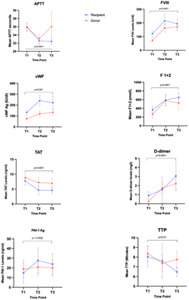Kohli, R; Platton, S; Forbes, S; Thuraisingham, R; Tan, J; Green, L; MacCallum, P
(2023)
Renal transplant and hemostasis: early postoperative changes in recipients and donors.
Research and Practice in Thrombosis and Haemostasis, 7 (4).
p. 100168.
ISSN 2475-0379
https://doi.org/10.1016/j.rpth.2023.100168
SGUL Authors: Tan, Joachim Wei Li
|
PDF
Published Version
Available under License Creative Commons Attribution Non-commercial No Derivatives. Download (1MB) | Preview |
|
|
Microsoft Word (.docx) (Supplementary material)
Published Version
Available under License Creative Commons Attribution Non-commercial No Derivatives. Download (31kB) |
||
![[img]](https://openaccess.sgul.ac.uk/115450/8.hassmallThumbnailVersion/1-s2.0-S2475037923001413-figs1_lrg.jpg)
|
Image (JPEG) (Supplementary Figure S1)
Published Version
Available under License Creative Commons Attribution Non-commercial No Derivatives. Download (345kB) | Preview |
Abstract
Background The benefit of administering pharmacologic thromboprophylaxis following renal transplantation remains uncertain. Objectives To compare hemostatic parameters before and after renal transplant surgery in both recipients and their donors at predetermined time points. Methods Blood samples were collected at baseline (T1), immediately after surgery (T2), and at 24 hours after surgery (T3) in both recipients and donors and at 72 (T4) and 120 hours (T5) from recipients only. Assays included in vitro thrombin generation, factor VIII (FVIIIc) activity, von Willebrand factor (VWF) antigen, D-dimer, antithrombin activity, prothrombin fragment 1 + 2 (F1 + 2), thrombin-antithrombin complexes, and plasminogen activator inhibitor-1 (PAI-1) antigen. Results Fifty-two patients (28 recipients and 24 donors) were enrolled. Both donors and recipients had increased FVIIIc, VWF, F1 + 2, D-dimer, and PAI immediately after surgery but reduced antithrombin. Mixed-model analysis showed that the magnitude of change over time (between T1 and T3) for FVIIIc (mean estimated difference [MED], 72; 95% CI, 41-102; P < .0001), VWF (MED, 89; 95% CI, 35-142; P = .001), F1 + 2 (MED, 283; 95% CI, 144-422; P < .0001), thrombin-antithrombin complexes (MED, 3.5; 95% CI, 1.9-5.1; P < .0001), D-dimer (MED, 2.2; 95% CI, 1.0-3.3; P < .0001), PAI-1 (MED, 9.2; 95% CI, 3.4-14.9; P = .002), and time to peak thrombin generation (MED, 1.5; 95% CI, 0.35-2.7; P = .01) was more significant in recipients than in donors. Conclusion Persistence of a hypercoagulable state was more prominent in recipients after 24 hours despite recovery in renal function and initiation of thromboprophylaxis.
| Item Type: | Article | |||||||||
|---|---|---|---|---|---|---|---|---|---|---|
| Additional Information: | © 2023 The Authors. Published by Elsevier Inc. on behalf of International Society on Thrombosis and Haemostasis. This is an open access article under the CC BY-NC-ND license (http://creativecommons.org/licenses/by-nc-nd/4.0/) | |||||||||
| SGUL Research Institute / Research Centre: | Academic Structure > Population Health Research Institute (INPH) | |||||||||
| Journal or Publication Title: | Research and Practice in Thrombosis and Haemostasis | |||||||||
| ISSN: | 2475-0379 | |||||||||
| Language: | en | |||||||||
| Dates: |
|
|||||||||
| Publisher License: | Creative Commons: Attribution-Noncommercial-No Derivative Works 4.0 | |||||||||
| Projects: |
|
|||||||||
| URI: | https://openaccess.sgul.ac.uk/id/eprint/115450 | |||||||||
| Publisher's version: | https://doi.org/10.1016/j.rpth.2023.100168 |
Statistics
Actions (login required)
 |
Edit Item |


